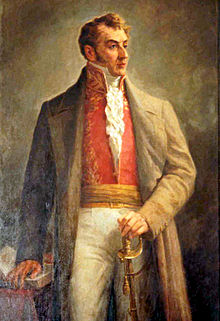Antonio Nariño
| Antonio Nariño | |
|---|---|

Oil painting by Ricardo Acevedo Bernal.
|
|
| Vice President of the Republic of Colombia | |
|
In office April 4, 1821 – June 6, 1821 |
|
| President | Simón Bolívar |
| Governor President of the State of Cundinamarca | |
|
In office September 19, 1813 – May 14, 1814 |
|
| Preceded by | Manuel Benito de Castro |
| Succeeded by | Manuel de Bernardo Álvarez del Casal |
| Governor President of the State of Cundinamarca and Viceregent of the King's Person | |
|
In office September 21, 1811 – August 19, 1812 |
|
| Monarch | Ferdinand VII |
| Preceded by | Jorge Tadeo Lozano |
| Succeeded by | Manuel Benito de Castro |
|
In office September 12, 1812 – September 19, 1813 |
|
| Preceded by | Manuel Benito de Castro |
| Personal details | |
| Born |
Antonio de la Santísima Concepción Nariño y Álvarez April 9, 1765 Bogotá, Viceroyalty of New Granada |
| Died | December 13, 1823 (aged 58) Villa de Leyva, Cundinamarca, Colombia |
| Nationality | Neogranadine |
| Political party | Centralist |
| Spouse(s) | Magdalena Ortega y Mesa |
| Religion | Roman Catholic |
Antonio Amador José de Nariño Bernardo del Casal (Santa Fé de Bogotá, Colombia 1765 – 1824 Villa de Leyva, Colombia) was a Colombian ideological of the independence movement in New Granada (present day Colombia) as well as one its of early political and military leaders.
Nariño was born to an aristocratic family. He was intellectually curious and admired the political ideologies of the leaders of the French and American Revolutions. In his impressive library there was a portrait of Benjamin Franklin above the mantle. In his youth, Nariño was a strong influence among the progressive young people of Bogotá, Colombia, hosting many secret political gatherings where the need for independence and the means of achieving it were discussed. Nariño was one of the most out-spoken and articulate participants at these meetings, and was widely respected by his fellow revolutionaries.
In 1794, Nariño procured a copy of the "Declaration of the Rights of Man", which was being distributed by the French Assembly. He translated the Declaration of the Rights of Man from its original French into Spanish and printed several copies from his own private press. He then circulated these translated pamphlets among his politically like-minded friends. Copies of the pamphlet were distributed to all corners of the continent and created a stirring in the political mentalities of the time. The government soon discovered the material and any copy that was found was burned. Nariño was sentenced to ten years of imprisonment in Africa for his leading role in the political group and was exiled from South America. Nariño had previously worked as a tax collector (Recaudador de diezmos) and was also accused of fraud resulting from this activity.
However, when the ship landed in Spain, Nariño escaped from his captors and later went to France and England, where he continued his work supporting the revolution in South America. He found his way back to New Granada (Colombia) where the authorities again caught up with him in Bogotá. This time he was imprisoned and sent to Madrid but somehow managed to escape again and return to Colombia, where he was able to take part in the revolution. He founded the political newspaper La Bagatela in 1811. That same year he was selected president of the State of Cundinamarca.
...
Wikipedia
